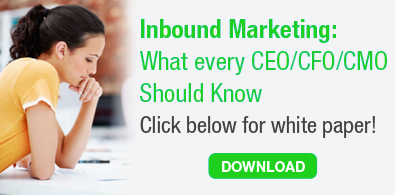Today we will break down one of the most important inbound marketing strategies of them all, attracting, converting and closing the customer. There is a famous quote by Alec Baldwin in the movie Glengarry Glen Ross, “ABC, Always be closing!” While closing does lead to sales and is the ultimate goal in business to consumer and business to business marketing plans, inbound marketing takes somewhat of a different approach than the “Always be closing” or, every sales manager’s favorite term the “One Call Close.”
The Inbound sales process is Buyer Centric. Attract your ideal customer with content, listen to what the potential buyer has to say about your content, and leverage the buyer’s thoughts into a sale. Transformation of the sales process in the inbound marketing strategy is essential to getting the customers to become leads and the leads to become sales. You must transform the way accounts are targeted,researched and prospected. There is an extensive amount of resources in an inbound marketing sales system than in a traditional “Always Be Closing” approach. In the inbound marketing process, a sales person will know more about their leads before ever talking to them in person.
Below are the 3 primary steps in how to close a sale using inbound marketing
Inbound marketing is all about placing the right content in the right place at the right time that targets the ideal consumers. Inbound marketing is not just about driving traffic to your website, it’s about drawing people in (through search) who are actually interested in what you’re selling.
The first question you need to ask yourself when creating inbound marketing content is: Who do I want to talk to and what are their buyer personas? Personas are made up characters which embody the characteristics, personality traits, demographic attributes and personal interests that control or influence the buying behavior of your target audience. Some things to consider:
- What are the demographics, for example, age, gender, personal interests, etc.?
- Where do they live, nationality, income level?
- What is their problem, and how can you solve that problem?
- What are their decision criteria when considering your solution?
Inbound marketing will help you attract the right people through the use of blogs, keywords, and social media that feature content relevant to your target audience.
- Companies who blog get 55% more traffic on their website than those who don’t.
- Companies who promote their blogs get 70% more leads than those who don’t.
If you create the right content – that meet a consumer’s buyer persona – the right people will come.
How do you convert visitors into leads? You get valuable contact information from them, and provide them with something they want in return (meaningful content that addresses the question they were searching for). To capture a visitor’s contact information, you use call-to-action landing pages and forms.
Calls-to-action
Calls-to-action encourages visitors to your site to engage with your content or promotions. It is important to create strong calls-to-action that entices them to learn more otherwise it will not produce the response you desire. Here are some typical calls-to-actions:
- Buy Now & Get 15% Off
- Call Today for a Free Audit
- Schedule an Appointment
Landing pages
Landing pages are the web pages that visitors are sent to when they click on a call-to-action button. Before you provide consumers with the content they are looking for, like the white paper on how to grow a vegetable garden, you ask visitors to provide you with their contact information. By providing their contact information, they are giving you the opportunity and permission to engage with them again.
Forms
Forms are how you will collect visitors’ information. Make forms as simple as possible, while still getting the necessary information. Users will rethink their need for your content if forms are too complicated, time consuming or intrusive. At the very least, you want to get a person’s email address. When you get information about a visitor is and how you can get in touch with them, they become leads.
Prospects have been checking out your inbound marketing material and have given you permission to contact them. So, how do you take them from lead to paying customer? You nurture them.
Nurturing a lead is all about sending them appropriate content throughout the sales cycle. When your prospects download the content created for them you send them an email thanking them for their interest. You can follow-up with additional emails to introduce other related content. Your ideal consumer searched for relevant content, and now that you know what they’re looking for and you know how to contact them, you can send them information about your company that is relevant to them.
By sending them relevant information, you are giving them the opportunity to decide to buy from you. When consumers make the decision to work with you based on their online research, they develop a level of trust with you that traditional outbound advertising can rarely create.
When your prospects show indications they are ready to buy your product or service, consider having a Call-To-Action (CTA) plan to push them towards the sale. Typical CTAs include:
- Buy Before December 1st and Get 15% Off
- Click here for a 10% off coupon
- Call today for a free evaluation
- Contact us today to schedule an appointment
By showing your prospects you care, with rich information or motivating CTAs, your leads will convert to customers.
Acquiring leads through content marketing can be very powerful in the fact that everything can be managed and monitored. Every blog, white paper, e-book, landing page, CTA, form, email and so on has data and information that can tell you about potential customers. What kind of prospect downloaded e-book A? Which kind of prospect clicked on CTA C? These are questions that inbound marketing provides the answers to. You’re able to see what kind of content is attracting what type of customer. In addition, you can also see what needs to be changed if content becomes unsuccessful in attracting and converting leads.
The result from inbound marketing data helps the sales force before making a sales call. Sales people will have the ability to build rapport based on the information known about the prospect from their own research. A commonality will already exist between a potential client and the sales person. A client’s needs will have already been addressed through research and prior communication. Research based on the specific content that attracts specific customers can be powerful. The sales person will know the path the prospect has taken through the sales funnel. Sales people come will be viewed as a trusted advisor. Inbound marketing turns what were once cold calls into friendly, knowledgeable and meaningful warm calls that bring friendly, knowledgeable and meaningful sales.


_(1).png?width=190&height=84&name=TMD_LOGO_338x149_(web)_(1).png) The Marketing Department Malvern, PA is a full service Marketing Agency serving Malvern, Main Line, King of Prussia, Wayne, Paoli, Berwyn, Chester County and Montgomery County, PA areas.
The Marketing Department Malvern, PA is a full service Marketing Agency serving Malvern, Main Line, King of Prussia, Wayne, Paoli, Berwyn, Chester County and Montgomery County, PA areas.